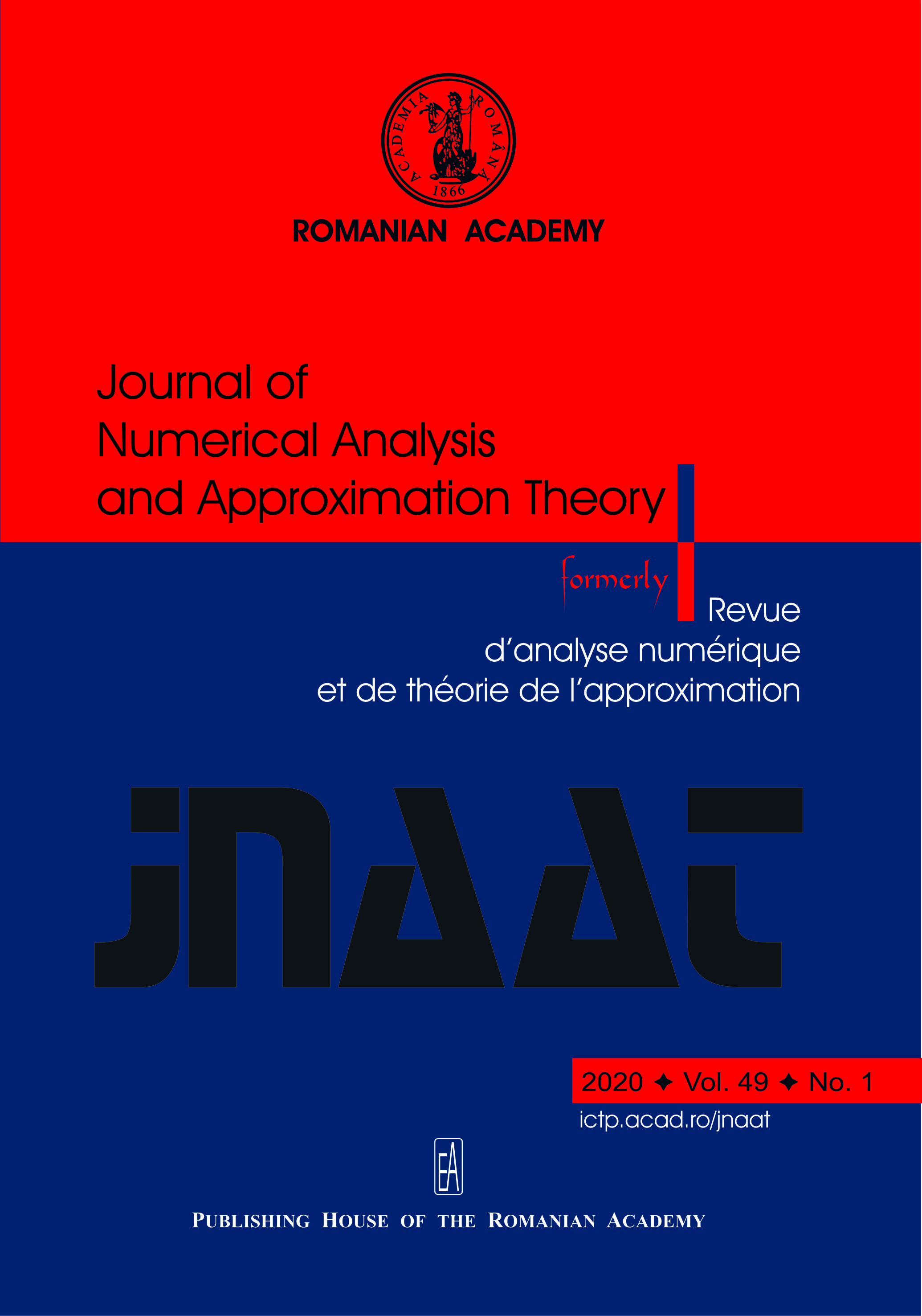Infinitely homoclinic solutions in discrete hamiltonian systems without coercive conditions
DOI:
https://doi.org/10.33993/jnaat491-1204Keywords:
homoclinic solutions, discrete Hamiltonian systems, symmetric mountain pass theoremAbstract
In this paper, we investigate the existence of infinitely many solutions for the second-order self-adjoint discrete Hamiltonian system
$$
\Delta\left[p(n)\Delta u(n-1)\right]-L(n)u(n)+\nabla W(n,u(n))=0, \tag{*}
$$
where \(n\in\mathbb{Z}, u\in\mathbb{R}^{N}, p,L:\mathbb{Z}\rightarrow\mathbb{R}^{N\times N}\) and \(W:\mathbb{Z}\times\mathbb{R}^{N}\rightarrow\mathbb{R}\) are no periodic in \(n\). The novelty of this paper is that \(L(n)\) is bounded in the sense that there two constants \(0<\tau_1<\tau_2<\infty\) such that
$$
\tau_1\left|u\right|^{2}<\left(L(n)u,u\right)<\tau_2\left|u\right|^{2},\;\forall n\in\mathbb{Z},\; u\in\mathbb{R}^{N},
$$
\(W(t,u)\) satisfies Ambrosetti-Rabinowitz condition and some other reasonable hypotheses, we show that (\(*\)) has infinitely many homoclinic solutions via the Symmetric Mountain Pass Theorem. Recent results in the literature are generalized and significantly improved.
Downloads
References
A. Ambrosetti, P.H. Rabinowitz, Dual variational methods in critical point theory and applications, J. Funct. Anal. 14 (1973), pp. 349-381, https://doi.org/10.1016/0022-1236(73)90051-7 DOI: https://doi.org/10.1016/0022-1236(73)90051-7
R.P. Agarwal, J. Popenda, Periodic solution of first order linear difference equations, Math. Comput. Modelling 22 (1) (1995), pp. 11-19, https://doi.org/10.1016/0895-7177(95)00096-k DOI: https://doi.org/10.1016/0895-7177(95)00096-K
R.P. Agarwal, K. Perera, D. O’Regan,Multiple positive solutions of singular discrete p-Laplacian problems via variational methods, Adv. Difference Equations 2005 (2) (2005) pp. 93-99, https://doi.org/10.1155/ade.2005.93
R.P. Agarwal, Difference Equations and Inequalities, Theory, Methods, and Applications, second ed., Dekker, New York, 2000, https://doi.org/10.1201/9781420027020 DOI: https://doi.org/10.1201/9781420027020
C.D. Ahlbrandt, A.C. Peterson, Discrete Hamiltonian Systems: Difference Equations, Continued Fraction and Riccati Equations, Kluwer Academic, Dordrecht, 1996. DOI: https://doi.org/10.1007/978-1-4757-2467-7
A. Chidouh, D. Torres, Existence of positive solutions to a discrete fractional boundary value problem and corresponding Lyapunov-type inequalities. Opuscula Math. 38 no. 1, (2018) pp. 31-40, https://doi.org/10.7494/opmath.2018.38.1.31 DOI: https://doi.org/10.7494/OpMath.2018.38.1.31
V. Coti Zelati, P.H. Rabinowitz, Homoclinic orbits for a second order Hamiltonian systems possessing superquadratic potentials, J. Amer. Math. Soc. 4 (1991) pp. 693-727, https://doi.org/10.1090/S0894-0347-1991-1119200-3 DOI: https://doi.org/10.1090/S0894-0347-1991-1119200-3
Y. Ding, S. Li, Homoclinic orbits for the first-order Hamiltonian systems, J. Math. Anal. Appl. 189 (1995) pp. 585-601, https://doi.org/10.1006/jmaa.1995.1037 DOI: https://doi.org/10.1006/jmaa.1995.1037
M. Gil’, Periodic solutions of abstract difference equation, Appl. Math. E-Notes 1 (2001) pp. 18-23.
Z.M. Guo, J.S. Yu, The existence of periodic and subharmonic solutions of subquadratic second order difference equations, J. London Math. Soc. (2) 68 (2003) pp. 419-430, https://doi.org/10.1112/S0024610703004563 DOI: https://doi.org/10.1112/S0024610703004563
Z.M. Guo, J.S. Yu, The existence of periodic and subharmonic solutions for second order superlinear difference equations, Sci. China Ser. A 33 (2003) pp. 226-235 (in Chinese), https://doi.org/10.1112/s0024610703004563 DOI: https://doi.org/10.1360/03ys9051
A. Iannizzotto, V.D. Radulescu, Positive homoclinic solutions for the discrete p-Laplacian with a coercive weight function. Differential Integral Equations 2 7 no. 1-2, (2014), pp. 35–44.
H. Hofer, K. Wysocki, First order el liptic systems and the existence of homoclinic orbits in Hamiltonian systems, Math. Ann. 288 (1990) pp. 483-503, https://doi.org/10.1007/bf01444543 DOI: https://doi.org/10.1007/BF01444543
M. Izydorek, J. Janczewska, Homoclinic solutions for nonautonomous second order Hamiltonian systems with a coercive potential, J. Math. Anal. Appl., 335 (2007) pp. 1119-1127, https://doi.org/10.1016/j.jmaa.2007.02.038 DOI: https://doi.org/10.1016/j.jmaa.2007.02.038
J. Mawhin, M. Willem, Critical Point Theory and Hamiltonian System, Springer-Verlag, New York, 1989, https://doi.org/10.1007/978-1-4757-2061-7 DOI: https://doi.org/10.1007/978-1-4757-2061-7
M. Migda, J. Migda, M. Zdanowicz, On the convergence of solutions to second order neutral difference equations. Opuscula Math.39, no. 1, (2019) pp. 61-75, https://doi.org/10.1007/978-1-4757-2061-7 DOI: https://doi.org/10.7494/OpMath.2019.39.1.61
W. Omana, M. Willem, Homoclinic orbits for a class of Hamiltonian systems, Differential Integral Equations, 5 (1992) pp. 1115-1120.
A. Pankov, Homoclinics for strongly indefinite almost periodic second order Hamiltonian systems. Adv. Nonlinear Anal. 8 no. 1, (2019) pp. 372-385, https://doi.org/10.1515/anona-2017-0041 DOI: https://doi.org/10.1515/anona-2017-0041
A. Pankov, N. Zakharchenko, On some discrete variational problems, Acta Appl. Math. 65 (1–3) (2001) pp. 295-303, https://doi.org/10.1023/a:1010655000447 DOI: https://doi.org/10.1023/A:1010655000447
H. Poincare, Les methodes nouvel les de la mecanique celeste, Gauthier-Villars, Paris,1899.
P.H. Rabinowitz, Minimax Methods in Critical Point Theory with Applications in Differential Equations, CBMS Reg. Conf. Ser. Math.,35, Amer. Math. Soc., Providence, RI, 1986, https://doi.org/10.1090/cbms/065 DOI: https://doi.org/10.1090/cbms/065
E. Sere, Existence of infinitely many homoclinic systems, Math. Z. 209 (1992) pp. 27-42, https://doi.org/10.1007/bf02570817 DOI: https://doi.org/10.1007/BF02570817
S. Stevic, Solvability of a product-type system of difference equations with six parameters. Adv. Nonlinear Anal. 8 no. 1, (2019) pp. 29-51. DOI: https://doi.org/10.1515/anona-2016-0145
K. Tanaka,Homoclinic orbits in a first-order superquadratic Hamiltonian system: Convergence of subharmonic orbits, J. Differential Equations 94 (1991) pp. 315-339, https://doi.org/10.1016/0022-0396(91)90095-q DOI: https://doi.org/10.1016/0022-0396(91)90095-Q
J.S.W. Wong,On the generalized Emden–Fowler equation, SIAM Rev. 2 (17) (1975) pp. 339-360, https://doi.org/10.1137/1017036 DOI: https://doi.org/10.1137/1017036
J.S. Yu, Z.M. Guo, X.F. Zou, Positive periodic solutions of second order self-adjoint difference equations, J. London Math. Soc. 71 (2) (2005) pp. 146-160, https://doi.org/10.1112/s0024610704005939 DOI: https://doi.org/10.1112/S0024610704005939
Published
Issue
Section
License
Copyright (c) 2020 Journal of Numerical Analysis and Approximation Theory

This work is licensed under a Creative Commons Attribution 4.0 International License.
Open Access. This article is distributed under the terms of the Creative Commons Attribution 4.0 International License, which permits unrestricted use, distribution, and reproduction in any medium, provided you give appropriate credit to the original author(s) and the source, provide a link to the Creative Commons license, and indicate if changes were made.










